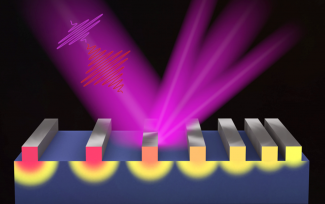Uncovering and engineering new regimes of nanoscale heat transport
Heat transport is driven by a thermal gradient, flowing from hot to cold regions in a material. However, at dimensions <100nm, bulk models no longer accurately predict the transport properties of materials. Because no complete models of nanoscale heat transport were available, it was assumed instead that bulk-like diffusive heat transport was valid—provided that an effective parameter, such as a size-dependent thermal conductivity, was incorporated. This makes it challenging to implement smart predictive designs for thermal management in nanodevices. This lack of understanding precluded technological progress to push clock speed beyond Terahertz frequencies due to heat accumulation in devices.
In exciting recent research, we used the exquisite sensitivity of dynamic EUV scatterometry to better capture nanoscale heat flow, with ~ picometer precision. This made it possible to observe, generalize, and understand a surprising experimental finding - an array of closely-spaced nanoscale heat sources can cool more quickly than when spaced far apart, due to better coupling to the phonon spectrum in the substrate. We are exploring a broad range of materials and structures to map out this unexpected behavior, first in 1D and now in 2D nanostructures—where in 2D, these effects are even larger. Moreover, using these comprehensive data sets, we are working with theory to develop better predictive theories for nanoscale thermal management—from atomistic to hydrodynamic. These more advanced theories can replace previous phenomenological models that require the use of geometry-dependent fitting parameters, and can also explain from a fundamental perspective how and why nanoscale heat transport is different. We recently found that cooling of 1D and 2D nanoscale hot spots can be far better described if a new and general hydrodynamic heat transport regime is also incorporated. These new EUV metrologies can guide the design of energy-efficient nano and quantum devices, where better thermal management is critically needed.
Related Publications
-
Brendan McBennett, Albert Beardo*, Emma E. Nelson, Begoña Abad, Travis D. Frazer, Amitava Adak, Yuka Esashi, Baowen Li, Henry C. Kapteyn, Margaret M. Murnane, and Joshua L. Knobloch*, “Universal Behavior of Highly Confined Heat Flow in Semiconductor Nanosystems: From Nanomeshes to Metalattices,” Nano Letters 23 (6), 2129-2136 (2023). DOI: 10.1021/acs.nanolett.2c04419
-
Hossein Honarvar, Joshua L. Knobloch, Travis D. Frazer, Begoña Abad, Brendan McBennett, Mahmoud I. Hussein, Henry C. Kapteyn, Margaret M. Murnane, and Jorge N. Hernandez-Charpak, “Directional thermal channeling: A phenomenon triggered by tight packing of heat sources,” PNAS 118, e2109056118 (2021). DOI: 10.1073/pnas.2109056118
-
Albert Beardo*, Joshua L. Knobloch*, Lluc Sendra, Javier Bafaluy, Travis D. Frazer, Weilun Chao, Jorge N. Hernandez-Charpak, Henry C. Kapteyn, Begoña Abad, Margaret M. Murnane, F. Xavier Alvarez, Juan Camacho, “A General and Predictive Understanding of Thermal Transport from 1D- and 2D-Confined Nanostructures: Theory and Experiment,” ACS Nano 15 (8), 13019-13030 (2021). DOI: 10.1021/acsnano.1c01946
-
T. D. Frazer, J. L. Knobloch, K. M. Hoogeboom-Pot, D. Nardi, W. Chao, R. W. Falcone, M. M. Murnane, H. C. Kapteyn, J. N. Hernandez-Charpak, “Engineering nanoscale thermal transport: Size- and spacing-dependent cooling of nanostructures,” Physical Review Applied 11, 024042 (2019). DOI: 10.1103/ PhysRevApplied.11.024042
-
K. M. Hoogeboom-Pot, J. N. Hernandez-Charpak, X. Gu, T. Frazer, E.H. Anderson, W. Chao, R. Falcone, R. Yang, M. M. Murnane, H. C. Kapteyn, D. Nardi, “A new regime of nanoscale thermal transport: collective diffusion increases dissipation efficiency,” PNAS 112, 4846–4851 (2015). DOI: 10.1073/pnas. 1503449112
-
K. M. Hoogeboom-Pot, J. N. Hernandez-Charpak, X Gu, E. Turgut, E. Anderson, W. Chao, J. Shaw, R. Yang, M. M. Murnane, and H. C. Kapteyn, “Mechanical and thermal properties of nanomaterials at sub-50nm dimensions characterized using coherent EUV beams,” in Proceedings of SPIE Vol. 9424, Metrology, Inspection, and Process Control for Microlithographys XXIX, 942417-1 (2015). DOI: 10.1117/12.208561
-
Mark Siemens, Qing Li, Ronggui Yang, Keith Nelson, Erik Anderson, Margaret Murnane and Henry Kapteyn, “Quasi-ballistic thermal transport from nanoscale interfaces observed using ultrafast coherent soft X-ray beams,” Nature Materials 9, 26 (2010). DOI: 10.1038/nmat2568



 The Physics Frontiers Centers (PFC) program supports university-based centers and institutes where the collective efforts of a larger group of individuals can enable transformational advances in the most promising research areas. The program is designed to foster major breakthroughs at the intellectual frontiers of physics by providing needed resources such as combinations of talents, skills, disciplines, and/or specialized infrastructure, not usually available to individual investigators or small groups, in an environment in which the collective efforts of the larger group can be shown to be seminal to promoting significant progress in the science and the education of students. PFCs also include creative, substantive activities aimed at enhancing education, broadening participation of traditionally underrepresented groups, and outreach to the scientific community and general public.
The Physics Frontiers Centers (PFC) program supports university-based centers and institutes where the collective efforts of a larger group of individuals can enable transformational advances in the most promising research areas. The program is designed to foster major breakthroughs at the intellectual frontiers of physics by providing needed resources such as combinations of talents, skills, disciplines, and/or specialized infrastructure, not usually available to individual investigators or small groups, in an environment in which the collective efforts of the larger group can be shown to be seminal to promoting significant progress in the science and the education of students. PFCs also include creative, substantive activities aimed at enhancing education, broadening participation of traditionally underrepresented groups, and outreach to the scientific community and general public.